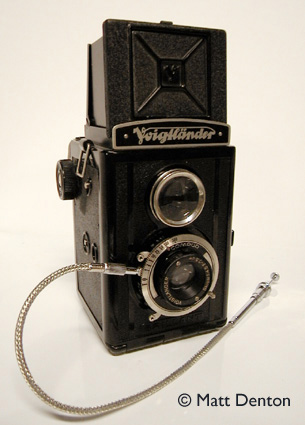- Produced 1930s Voigtlander Braunshweig, Germany
- Film type 120
- Picture size 6cm x 6cm
- Weight 20.2oz (572.7g)
- Lens uncoated 3-element Voigtlander Skopar 75mm f4.5 (stops to f16)
- Filter size 27mm push-on
- Focal range 3′ to infinity
- Shutter Compur
- Shutter speeds T, B, 1, 2, 5, 10, 25, 50, 100, 300
- Viewfinder TLR, lenslike focusing screen (not ground glass)
- Exposure meter none
Overview
Another gem in this collection is the bakelite Brilliant V6 by Voigtlander (a company once associated with Zeiss Ikon, and Rollei in turns, now resurrected by Cosina with its retro-revolutionary Bessa-R and Bessa-L.) Reportedly the inspiration for the Russian Lubitel but with automatic frame counting and a relatively fast shutter. Sharp but slightly slow lens. It is a pleasure to use, almost feels like my ‘toy’ Lubitel indeed. To be fair, the Lubitel has a coated lens and flash sync, not to mention geared focusing. But the little Skopar is clear, sharp and contrasty with nice depth-of-field dropoff giving you a nice old-fashioned look to the pictures. I really like the way pictures taken with this camera come out. Turns out that zone focusing isn’t as difficult as I thought. Plus there’s a chart on the camera if you have time to read it. I find myself using this one over the Lubitel even though it makes me nervous sometimes, realizing that it’s so old.
The original Brilliant was metal rather than bakelite, and with its fixed-focus lens was more akin to box cameras than TLRs. In 1938 Voigtlander added a geared focusing between the viewing and taking lenses and renamed the camera the ‘Focusing Brilliant’. I don’t think it worked quite as well as the geared focusing that was introduced by the Russians on the Lubitel. A Lubitel-2 is a very very similar looking camera to the Brilliant except it has flash sync (even then!) in addition to the geared focusing making it an excellent alternative to this old beauty.
Repairs
My second major camera repair, this one – what I thought was a dirty mirror when I got it was in fact a mirror in desperate need of resilvering. No place I talked to could help me – the antique glass was far too thin (about 1.5mm) and no one seemed to know how to resilver a mirror. So I got a glass cutter at Pini Hardware for $3.29 and a little square mirror at Ben Franklin Crafts for $.99 and cut myself a replacement. Now it’s a like-new camera and using it I have to remind myself I’m handling a 65-year-old antique!
Tips & Tricks
Learn zone focusing. On the left view window flap there is a depth-of-field chart which helps but in general don’t think you’re going to get grab shots with a zone focus camera. These oldies are for planned, carefully framed shots. Carry a tape measure in your camera bag or get an accessory rangefinder like the old Ideal or Kodak pocket finders.It’s in the manual but I’ll say it anyway – to advance the film you must push the release lever next to the film wind knob before you can turn the knob. Other cameras with a release button: the Argus C3, Kodak 35 RF. It’s just a little something extra to add to your picture-taking experience.
Other tips: the lens is uncoated which supposedly means a potential for flare, though I’ve never seen any hint of that even when shooting in full noon sun, see example. I like to use use fast (320-400) film due to the slowness of the lens, though 125 would be fine in most situations. A Kodak film canister lid fits perfectly as a slip-on lens cap. Just poke a hole or two to let out air and moisture. Filters are available as there is a compartment for them in the side of the camera, but I haven’t seen them myself and have heard that they are of 27mm push-on type.
Related Links
